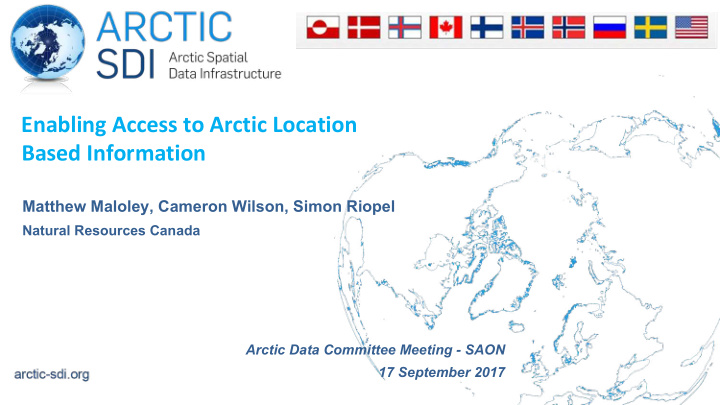



Enabling Access to Arctic Location Based Information Matthew Maloley, Cameron Wilson, Simon Riopel Natural Resources Canada Arctic Data Committee Meeting - SAON 17 September 2017
What is Arctic SDI? Video: • Arctic SDI 101 • AC endorsed 2009 • MoU in Place • Strategic Plan • Technical Implementations • Publications http://wallpaper.imcphoto.net/animals/polar-bear/polar-bear-on-ice.jpg
A Cooperative Model in the Arctic The Arctic SDI is focused on – Working with organizations to make their data available, with a focus on the Arctic Council. – Understanding the needs and requirements of stakeholders. – Information Management best practices (lifecycle of geospatial data). – Open data standards and provision of authoritative data. Graphic Source: OGC
Arctic SDI provides an Authoritative Reference Basemap provided directly from the 8 Arctic National Mapping Agencies Southern Svalbard: Arctic SDI Basemap vs. Google Maps Arctic SDI provides access to all forms of authoritative data
Arctic SDI is Partnering to Enhance Data Management Best Practices Collaborating with Arctic Council Working Groups to develop common data sharing methodologies and best practices: • MODIS satellite data derived products (2002-2012) and migratory birds index published ABDS based SDI web standards (ISO, OGC), • Contributing to the data management plan of the Biodiversity Monitoring Stations (Iceland, Canada, Greenland) project lead by CAFF, • Collaborating with CAFF and PAME to enable time series embedded maps of the new protected areas database (1900-2016), • Assisting with CAFF’s Earth Observation Plan to acquire and distribute derived products for Landsat EO data (1970 to present), • Arctic Council Working Group Meeting, September 2015, Tromsø; Standardized Geospatial Data Management and Sharing. 11,4 % protected 4,7 % marine 20,2 % terrestrial
Arctic SDI is Partnering to Enhance Data Management Best Practices - Engagement Collaborating with different Arctic stakeholders: • Provinces and Territories –The SDI Manual for the Arctic provides data management practices and guidelines for efficient monitoring and decision making in the Arctic. • Academia / Indigenous Communities – Canadian Consortium for Arctic Data Interoperability, Polar Data Workshop II • Industry - Spatineo Harvesting of Web Services (+1000) • NGO - OGC Request for Information (30+ organisations replied), Gordon Foundation - DataStreams
Pan-Arctic Digital Elevation Map US Arctic Council Chairmanship Initiative Gets World Visibility: President Obama Announces Investments to Combat Climate Change • Funded by the USA National Science Foundation, • Arctic SDI Board provided elevation experts to review and increase product accuracy, • Arctic SDI published a position statement providing enthusiastic support, • National Mapping Authorities provide sustainable 7 support of elevation models and continuous improvement as part of their operations.
Arctic Spatial Data Pilot - Climate Change Scenarios ▪ Sponsored by NRCan and USGS, this Open Geospatial Consortium Arctic Spatial Data Pilot: ▪ Defined land and sea climate change scenarios to break down information management silos with technical piloting activities: ▪ Improve access to reliable data for monitoring, management, emergency preparedness and decision making in the Arctic, ▪ Produce a video to showcase how standards and common approaches to data management are deployed. ▪ Addressed technology issues to meet the realities of Arctic frontier economies, such as in zero/low bandwidth Internet. http://www.opengeospatial.org/projects/initiatives/arcticsdp http://www.opengeospatial.org/pub/ArcticSDP/pilot-initiative.html 8
Arctic Spatial Data Pilot – Summary Video Goal: Demonstrating the diversity, richness and value of providing geospatial data using international standards in support of spatial data exchange. 9
Arctic Spatial Data Pilot - Videos VIDEOS Case Studies by Pilot Participants
Arctic Spatial Data Pilot - Conclusions ▪ If data is documented and standardized, integration in data processing workflows is extremely efficient. ▪ Limited telecom resources/bandwidth issues in North. ▪ High value data not being delivered via standard services, lack of consolidated catalogs, and almost no relevant inventory of available services produce high entry hurdles for Northerners. ▪ End users need to implement with best practices, provide appropriate descriptions, categorize information, and link to information and services. ▪ Semantic Web is still in its infancy, humans remain at key positions for data discovery, exploration, and application.
We Are All Stakeholders • Ecosystem-based analysis requires seamless sharing of data across jurisdictions and organizations. • Arctic SDI is providing shared tools and information management practices to Arctic stakeholders to break down silos. • Arctic SDI brings together the National Mapping Agencies, trusted map data and geospatial data expertise. arctic-sdi.org 12 Source: blogs.vmware.com
Recommend
More recommend